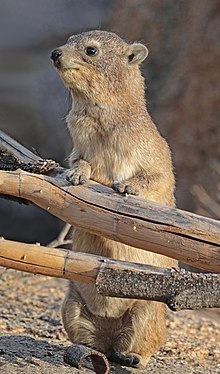| Rock hyrax[1] | |
|---|---|

| |
| At Erongo, Namibia | |
| Scientific classification | |
| Domain: | Eukaryota |
| Kingdom: | Animalia |
| Phylum: | Chordata |
| Class: | Mammalia |
| Order: | Hyracoidea |
| Family: | Procaviidae |
| Genus: | Procavia |
| Species: | P. capensis
|
| Binomial name | |
| Procavia capensis (Pallas, 1766)
| |
| Subspecies | |
|
See text | |

| |
range
| |
The rock hyrax (/ˈhaɪ.ræks/; Procavia capensis), also called dassie, Cape hyrax, rock rabbit, and (from some[3] interpretations of a word used in the King James Bible) coney, is a medium-sized terrestrial mammal native to Africa and the Middle East. Commonly referred to in South Africa as the dassie (IPA: [dasiː]; Afrikaans: klipdassie),[4] it is one of the five living species of the order Hyracoidea, and the only one in the genus Procavia.[1] Rock hyraxes weigh 4–5 kg (8.8–11.0 lb) and have short ears.[4]
Rock hyraxes are found at elevations up to 4,200 m (13,800 ft) above sea level[5] in habitats with rock crevices, allowing them to escape from predators.[5][6] They are the only extant terrestrial afrotherians in the Middle East.[note 1] Hyraxes typically live in groups of 10–80 animals, and forage as a group. They have been reported to use sentries to warn of the approach of predators. Having incomplete thermoregulation, they are most active in the morning and evening, although their activity pattern varies substantially with season and climate.
Over most of its range, the rock hyrax is not endangered, and in some areas is considered a minor pest.
Along with other hyrax species and the sirenians, this species is the most closely related to the elephant.[7] An unrelated, convergently evolved mammal of similar habits and appearance is the rock cavy of Brazil.
- ^ a b Shoshani, J. (2005). "Order Hyracoidea". In Wilson, D.E.; Reeder, D.M (eds.). Mammal Species of the World: A Taxonomic and Geographic Reference (3rd ed.). Johns Hopkins University Press. pp. 88–89. ISBN 978-0-8018-8221-0. OCLC 62265494.
- ^ Butynski, T.; Hoeck, H.; Koren, L. & de Jong, Y.A. (2015). "Procavia capensis". IUCN Red List of Threatened Species. 2015: e.T41766A21285876. doi:10.2305/IUCN.UK.2015-2.RLTS.T41766A21285876.en. Retrieved 16 February 2022.
- ^ Ellicott's Commentary for English Readers (Leviticus 11:5)
- ^ a b "Hyrax". Encyclopaedia Britannica. Retrieved 30 October 2018.
- ^ a b George A. Feldhamer; Lee C. Drickamer; Stephen H. Vessey; Joseph F. Merritt; Carey Krajewski (2007). Mammalogy: Adaptation, Diversity, Ecology. JHU Press. p. 376. ISBN 9780801886959.
- ^ Adrienne Gear (2008). Nonfiction Reading Power: Teaching Students how to Think While They Read All Kinds of Information. Pembroke Publishers Limited. p. 105. ISBN 9781551382296.
- ^ Jane B. Reece; Noel Meyers; Lisa A. Urry; Michael L. Cain; Steven A. Wasserman; Peter V. Minorsky (2015). Campbell Biology Australian and New Zealand Edition. Pearson Higher Education AU. p. 470. ISBN 9781486012299.
Cite error: There are <ref group=note> tags on this page, but the references will not show without a {{reflist|group=note}} template (see the help page).
